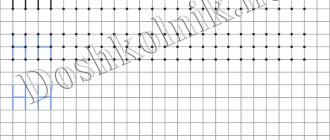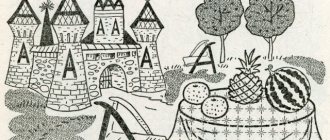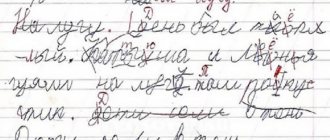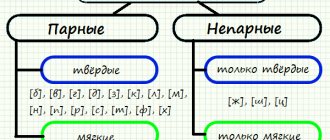General information
Before we talk about what kind of letter “th” is (soft or hard), you should find out why the letters of the Russian alphabet are generally divided according to such characteristics.
The fact is that each word has its own sound shell, which consists of individual sounds. It should be noted that the sound of a particular expression is completely correlated with its meaning. At the same time, different words and their forms have completely different sound design. Moreover, the sounds themselves have no meaning. However, they play a vital role in the Russian language. After all, thanks to them we can easily distinguish words. Here's an example:
- [house] – [lady’] – [house’];
- [m'el] - [m'el'], [tom] - [there], [house] - [volume].
Transcription
Why do we need information about what type of letter “th” is (hard or soft)? During phonetic analysis of a word, it is very important to correctly display the transcription that describes its sound. In such a system it is customary to use the following symbols:
[ ] – this designation is called square brackets. They must be placed to indicate transcription.
[´] is the accent. It is placed if the word has more than one syllable.
[b'] - a kind of comma is placed next to the consonant letter and denotes its softness.
By the way, during phonetic analysis of words the following symbol is often used – [j]. As a rule, it denotes the sound of the letter “th” (sometimes a symbol such as [th] is used).
Letter "y": consonant or vowel?
As you know, in the Russian language all sounds are divided into consonants and vowels. They are perceived and pronounced completely differently.
- Vowel sounds are those sounds during the pronunciation of which air easily and freely passes through the mouth, without encountering any obstacles on its way. Moreover, you can pull them, you can shout with them. If you put your palm to your throat, you can quite easily feel the work of the vocal cords during the pronunciation of vowels. There are 6 stressed vowels in the Russian language, namely: [a], [e], [u], [s], [o] and [i].
- Consonant sounds are those sounds during the pronunciation of which the air encounters an obstacle on its way, namely a bow or a gap. Their appearance determines the nature of the sounds. As a rule, a gap is formed when pronouncing [s], [w], [z] and [z]. In this case, the tip of the tongue approaches the upper or lower teeth. The presented consonants can be drawn out (for example, [z-z-z], [z-z-z]). As for the stop, such a barrier is formed due to the closure of the speech organs. The air, or rather its flow, abruptly overcomes it, making the sounds energetic and short. That is why they are called explosive. By the way, it is impossible to pull them (try it yourself: [p], [b], [t], [d]).
In addition to the above consonants, the Russian language also has the following: [m], [y], [v], [f], [g], [l], [r], [ch], [ts], [x] . As you can see, there are many more of them than vowels.
Summary of a literacy lesson “Sound [Y] and letter Y”
Abdulova Dzhume Sirazhutdinovna
Summary of a literacy lesson “Sound [Y] and letter Y”
Goal: To consolidate children's knowledge about the sound and letter J
Materials: demonstration material, workbooks part 2, a simple pencil, colored pens and pencils, tumblers, counting sticks, felt-tip pens for working at the board
I. Organizational moment
Educator: Today we will get acquainted with the new sound “Y”. The sound [Y] is indicated by the letter - and short (Y).
-What letter does it look like (I). This letter is very similar to the letter "I"
Educator;
The letter Y is called “And short”
“Y” is like “I” in a notebook.
So that Y is not confused with I
Write a tick at the top.
Educator;
The letter "Y" is lazy. It rarely occurs at the beginning of a word, and then only in foreign words iodine, yoga, yogurt
Educator;
Determine: vowel or consonant?
Place your fingers on the larynx and determine the voiced or unvoiced sound [Y'].
Tell me, what is the character of the sound [Y']?
Conclusion: The sound [Y'] is consonant, sonorous, always soft.
II. Main part.
One child does a task at the board.
Whoever has the sound Y in their name goes to the board. Yes, this is our Andrey
(Work in the notebook Elena Astafieva: We play, read, write. Workbook No. 2. Federal State Educational Standard).
1. Game exercise “Put the letter in her apartment”
Objectives: consolidate knowledge about the studied sound and letter; learn to choose the right and left front house, count the floors in order, starting from the bottom; explain the choice of your decision based on knowledge about sound.
Educator: Guys, look, in your notebook you have drawn a house for letters, the owner of this house is a tumbler. Andrey placed the letter Y on the first floor, under the letter L, in front of the letter R.
Educator: which tumbler do we choose?
Andrey: green with a bell
Educator: why?
Andrey : because Y is a consonant, voiced, and can only be soft
Educator : Now Andrey, find the sound Y in the words and write the letter Y. (the child writes a letter if he writes all the letters in short words)
1. We appreciate the words:
Parrot: Y- consonant, voiced, soft, located at the end of the word, written in green
Yod : Y- consonant, voiced, soft, located at the beginning of the word, written in green
Mike : Y- consonant, voiced, soft, located in the middle of a word, written in green
2. In empty cells, draw objects with the sound Y
Andrey:
Yogurt : Y- consonant, voiced, soft, located at the beginning of the word, written in green
Tram : Y- consonant, voiced, soft, located at the end of the word, write in green
Nightingale: Y- consonant, voiced, soft, located at the end of the word, write in green
Educator : What objects did Dasha and Zhenya draw?
Dasha : sparrow, yogurt, ant
Zhenya : Thumbelina, Aibolit, watering can
Educator: Well done guys, you did it all
2. Game exercise “Continue according to the example”
Goals: consolidate knowledge about sounds and letters. Training a child's visual memory
3. Exercise “Continue the ornament”
Goal: continue according to the example; develop visual memory
4. Exercise “Finish the drawing”
Goal: develop hand motor skills
5. Game "Transport"
Goals. Using the words: transport, air, water, city as an example, we train the ability to perform sound-letter analysis and synthesis of words. We develop the skill of dividing words into syllables. We consolidate knowledge on the topic “Transport”, the ability to distinguish between types of transport (water, air, city, railway).
Progress of the game. The adult offers to name and summarize in one word the objects presented in the picture (transport). The child performs a sound-letter analysis of the word transport. (The adult draws his attention to the difference in the pronunciation and spelling of the word: [transport], transport.)
The child names the letters missing in this word, writes them (T, R, N, S, P, R, T) and generalizes (consonants).
Assignment: remember the types of transport (air, water, city, railway). The child analyzes the words written under the pictures and performs a task with them similar to the previous one; fulfills the sound and syllabic schemes of the words water, air, urban.
The child indicates with arrows what type of transport each car belongs to.
An adult asks the question: “What type of transport was not mentioned in the game?” (Railway). The child lists cars related to this type of transport.
6. Game “Draw it yourself” Goals. We train the ability to write (copy) words. We consolidate knowledge about the correct spelling of the word transport. We develop the skill of sound-letter analysis and synthesis. We test your knowledge on the topic “Transport”.
Progress of the game. When performing a sound-letter analysis of the unfinished word transport, the child writes in the missing vowels, commenting on the correct spelling of this word. Then he analyzes the outline of the sentence that includes the word transport, and determines how many more words need to be added to this sentence. The adult explains that the word denoting the mode of transport is unfinished here. The child needs to enter (copy from the previous game “Transport”) the name of any type of transport. While completing the task, he remembers the rule: the first word in a sentence is written with a capital letter.
In conclusion, the child draws and names cars related to this type of transport.
7. Game "Tram"
Goals. We learn to divide words into syllables and determine the order of syllables in a word. Using the example of the words dump truck, truck, tram, we continue to develop the skill of sound-letter analysis and synthesis. We consolidate the ability to differentiate types of transport (freight and passenger transport). We develop visual attention, the ability to recognize objects by dotted patterns and independently complete such a pattern.
Progress of the game. The adult explains that in the written words you need to place the syllables correctly - then you can read the names of various cars. Having rearranged the syllables, the child reads and writes the words: dump truck, tram, truck.
It is proposed to determine which of the machines is redundant and why. (The tram is superfluous, since it is a passenger transport, and the rest of the cars are freight.) The child must find out which of the cars is drawn with dots (tram). The child completes the dotted drawing, colors it, signs the name, and completes the sound and syllable patterns of the word. An adult should draw the child's attention to the correct pronunciation and spelling of the word tram.
Summary of the lesson.
- So we got acquainted with the sound and letter Y.
- What can you say about this sound?
-Name words with the sound [Y].
- Guys, you tried your best today, listened carefully, answered well, everyone was great!
Voiced and voiced sounds
According to the relationship between voice and noise, consonant sounds can be either voiced or unvoiced. At the same time, during the pronunciation of voiced sounds, both noise and voice are heard, while deaf people hear only noise.
By the way, many consonant sounds form pairs of deafness and voicedness: [k] - [g], [b] - [p], [z] - [c], [d] - [t], [f] - [v], etc. In total, there are 11 such pairs in the Russian language. However, there are sounds that do not have pairs on this basis. These include: [y], [p], [n], [l], [m] are unpaired voiced ones, and [ch] and [ts] are unpaired voiceless ones.
Hissing and whistling consonants
The sounds [zh], [w], [h'], [sh'] are called hissing consonant sounds . The sounds [zh] and [sh] are unpaired solids
hissing consonants:
iron
[zhel'ezo],
six
[shest'];
but in combinations zhi, shi
s
is not written .
The combinations zhi, shi
are always written with the letter
and
:
live
here, gara
zhi
,
shi
lo, karanda
shi
.
The sounds [h'] and [h'] are unpaired soft
hissing consonants:
watch
[ch'asy],
pike
[sh'uka],
but in combinations cha, sha
the letter
a
, and in combinations
chu, schu
the letter
y
:
cha
shka
,
square
,
stocking
,
pike
. The sounds [z], [z'], [s], [s'], [ts] are called whistling consonants .
Soft and hard consonants
As you know, consonant letters differ not only in sonority or, conversely, deafness, but also in softness and hardness. This property is the second most important feature of sounds.
So, is the letter “th” hard or soft? To answer this question, you should consider each sign separately:
- When pronouncing soft consonants, the entire tongue moves slightly forward, and its middle part rises slightly.
- During the pronunciation of hard consonants, the entire tongue is literally pulled back.
It should be especially noted that many consonant letters form pairs with each other based on characteristics such as softness and hardness: [d] - [d'], [p] - [p'], etc. There are 15 such pairs in total. However, there are also sounds that do not have pairs on this basis. Which letters of hard consonant sounds are unpaired? These include the following - [w], [f] and [c]. As for unpaired soft ones, these are [sch'], [h'] and [th'].
Designation on the letter
Now you know the information about whether the letter “th” is hard or soft. But here a new question arises: “How is the softness of such sounds indicated in writing?” Completely different methods are used for this:
- The letters “e”, “yu”, “e”, “ya” after consonants (not counting “zh”, “sh”, and “ts”) indicate that these consonants are soft. Let's give an example: uncle - [d'a'd'a], aunt - [t'o't'a].
- The letter “i” after consonants (not counting “zh”, “sh”, and “ts”) indicates that these consonants are soft. Let's give an example: cute - [m'i´lyy'], leaf - [l'ist], threads - [n'i´tk'i].
- The soft sign (“b”) after consonants (not counting “zh” and “sh”) is an indicator of grammatical form. It also indicates that the consonants are soft. Examples: distance - [dal'], stranded - [m'el'], request - [proz'ba].
As you can see, the softness of consonant sounds in writing is conveyed not by individual letters, but by their combinations with the vowels “e”, “yu”, “e”, “ya”, as well as a soft sign. That is why, when analyzing a word phonetically, experts recommend paying attention to neighboring symbols.
As for the vowel letter “th”, it is always soft. In this regard, in transcription it is usually denoted as follows: [th']. That is, the comma symbol, indicating the softness of the sound, must always be inserted. [ш'], [ч'] also obey the same rule.
Letters and sounds
When children begin to learn letters and sounds in 1st grade, they sometimes confuse these concepts. However, letter and sound are completely different phonetic terms. A letter is a graphic icon. And sound is what we hear and pronounce. Each letter has certain sounds assigned to it, with which they correspond in most cases, but there is no direct similarity between them.
Transcription is a way of expressing the sounds we hear in writing. With its help, it is easy to trace the difference between a letter and a sound. For example, there are letters that do not have sounds assigned to them: a hard sign (Ъ) and a soft sign (b). Their function is to convey the hardness or softness of sound:
- mole - [mol] or mole - [mol'].
In addition, there are letters that can convey different sounds: we write “milk”, but pronounce [mALAko]. Also, the same letter can convey several sounds:
- my [may'o].
In view of this, it is not entirely correct to talk about consonants and vowels and sounds.






![Sound [Z]](https://lubcentre.ru/wp-content/uploads/zvuk-z-330x140.jpg)

